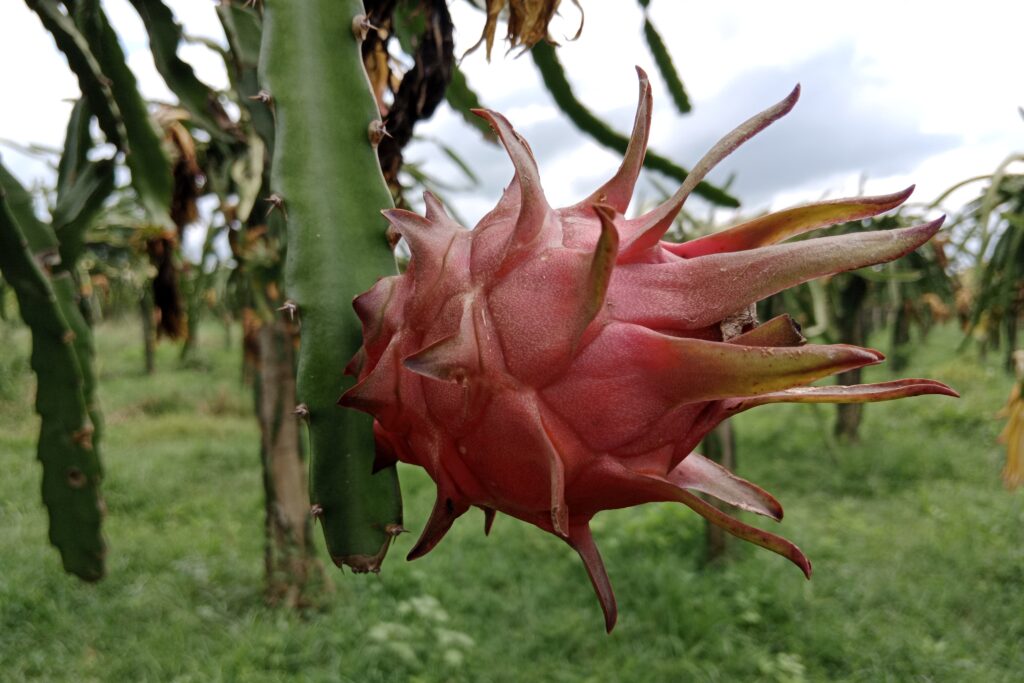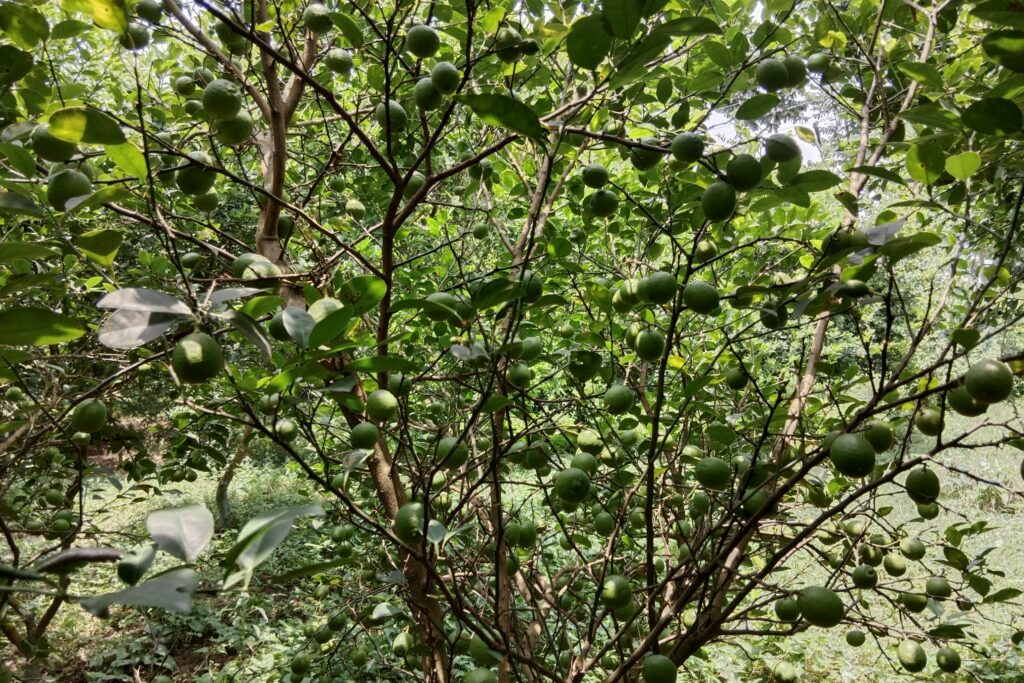Jackfruit Cultivation
Jackfruit cultivation is a rewarding endeavor, as jackfruit, popularly known as “poor man’s food,” is a highly nutritious fruit rich in vitamins A and C, carbohydrates, and essential minerals. Versatile fruit is used in various culinary applications, with immature tender fruits and seeds of ripe fruits being cooked, while ripe fruits are enjoyed fresh or processed into nectars, dehydrated leathers, jelly, chips, and papad.

Immature fruits are also used to make pickles, and the skin of ripe fruits, along with other fruit waste and leaves, serves as excellent cattle feed. This comprehensive guide for jackfruit cultivation provides valuable insights into growing this multipurpose fruit, ensuring optimal yield and quality for both consumption and commercial purposes.
Whether you are a beginner or an experienced farmer, mastering jackfruit cultivation can lead to sustainable agricultural practices and economic benefits, making it a vital addition to any farming system. Jackfruit farming involves several key practices to ensure healthy growth and high yield. Below is an explanation of the content provided:
Land Preparation
For a jackfruit plantation to be successful, the land must be prepared. To guarantee adequate aeration, drainage, and even water distribution, start by removing any weeds, debris, and rocks from the soil. Then, plough and level the ground. To improve soil fertility, water-holding capacity, and microbial activity—all of which are necessary for healthy tree growth and increased yields—incorporate organic matter such as compost or manure. Strong plant development is based on proper preparation.
Soil Type
Jackfruit thrives in deep, well-drained, fertile soils like sandy loam or loam, with an ideal pH range of 6.0 to 7.5. Poorly drained or waterlogged soils should be avoided, as they can harm root health. The crop grows well in plains and at elevations up to 1200 meters, making it adaptable to various conditions. Proper soil selection is crucial for healthy growth and high-quality fruit production.
Climatic Requirements for Jackfruit Cultivation
Jackfruit is well-suited to tropical and subtropical climates, where it can flourish under specific environmental conditions. The tree thrives in temperatures ranging from 25°C to 35°C, which provide the warmth necessary for vigorous growth and fruit development. Consistent temperatures within this range promote healthy photosynthesis, flowering, and fruiting.
Additionally, jackfruit requires an annual rainfall of 1,500 to 2,500 mm for optimal growth, as adequate moisture supports its large leaves and fruit production. However, once the tree is well-established, it exhibits a degree of drought tolerance, enabling it to survive periods of water scarcity. This adaptability makes jackfruit a resilient crop in regions with variable rainfall patterns. Proper climatic conditions, including warm temperatures and sufficient rainfall, are essential for maximizing the tree’s growth potential and ensuring high-quality fruit yields.
Major Cultivars
Jackfruit cultivation features diverse cultivars like ‘Singapore Jack,’ ‘Black Gold,’ ‘Golden Pillow,’ and ‘Honey Gold,’ each with unique traits such as sweetness, size, and texture. The choice of cultivar should align with local climate conditions and market demand, ensuring optimal yield, fruit quality, and profitability. Selecting the right variety enhances cultivation success and meets consumer preferences.
Planting of Jackfruit
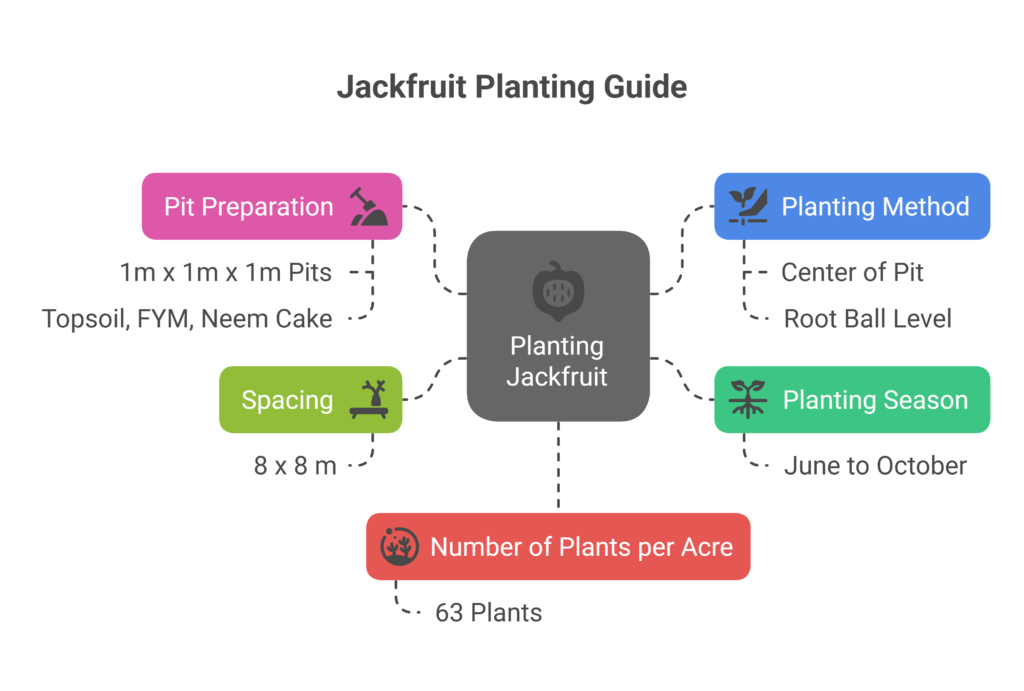
a). Planting Season
The planting season for jackfruit is a crucial factor that influences the successful establishment and growth of the trees. The ideal time for planting is between June and October, which typically coincides with the rainy season in many tropical and subtropical regions. Planting during this period ensures that the young saplings receive an adequate and consistent water supply, which is essential for root development and early growth.
b). Spacing
Plant preferably grafts during at 8 x 8 m spacing.
c). Pit Preparation
For pit preparation, dig pits measuring 1m x 1m x 1m. Fill these pits with a mixture of topsoil, 10 kg of farmyard manure (FYM), and 1 kg of neem cake per pit. This enriched soil mixture provides essential nutrients and promotes healthy root development for the jackfruit saplings.
d). Planting Method
Place the sapling in the center of the pit, ensuring the root ball is level with the soil surface.
e). Number of Plants per Acre
Approximately 63 plants can be planted per acre.
Intercropping
Intercropping is a highly beneficial practice for jackfruit cultivation, especially since jackfruit trees take several years to reach maturity and begin yielding fruit. During the initial years, the space between the trees can be effectively utilized by planting short-term crops such as vegetables (e.g., tomatoes, peppers, or leafy greens), legumes (e.g., beans or peas), or spices (e.g., turmeric or ginger).
This not only maximizes land use but also provides farmers with additional income while waiting for the jackfruit trees to mature. However, it is crucial to select intercrops that do not compete heavily with the jackfruit trees for essential resources like nutrients, water, or sunlight. Careful planning and management of intercropping systems can enhance soil fertility, reduce weed growth, and improve overall farm productivity, making it a sustainable and profitable approach for jackfruit cultivation.
Irrigation
The water requirement for a jackfruit plant varies depending on its growth stage, climate, soil type, and environmental conditions. Below is a general tabulated representation of the water requirement per jackfruit plant per day at different growth stages. Note that these values are approximate and may vary based on specific conditions.
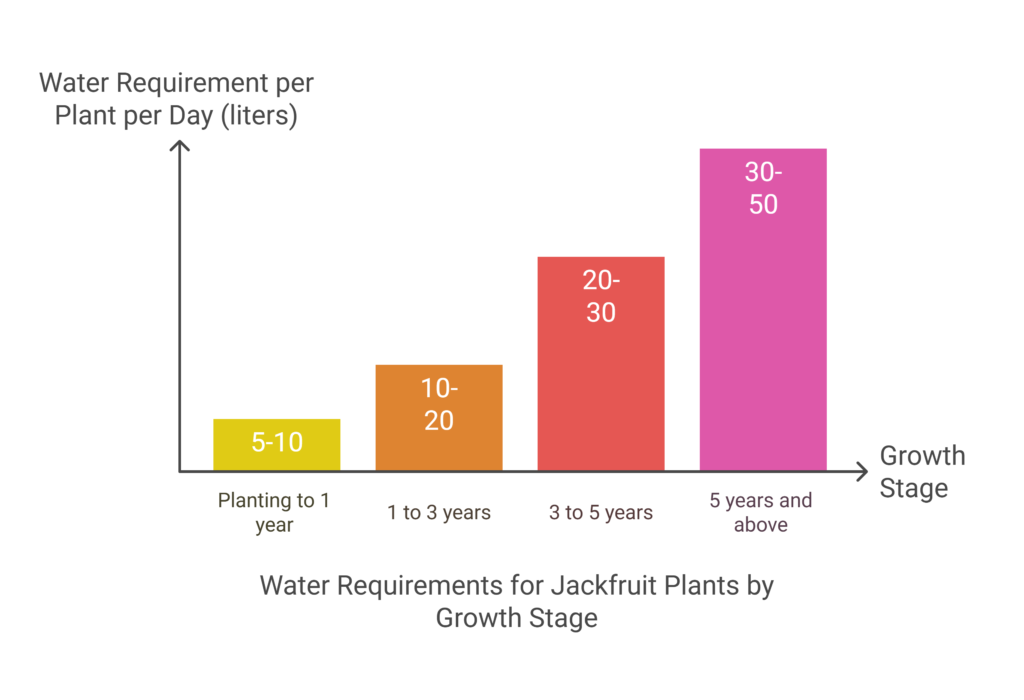
| Growth Stage | Water Requirement (Liters per Plant per Day) | Remarks |
| Planting to 1 year | 5-10 liters | Young plants require consistent moisture to establish roots. |
| 1 to 3 years | 10-20 liters | Increase water requirement as the plant grows and develops. |
| 3 to 5 years | 20-30 liters | The plant is maturing and requires more water for vegetative growth. |
| 5 years and above | 30-50 liters | Mature trees require more water, especially during flowering and fruiting. |
Fertilizer and Manure for Jackfruit Cultivation
The growth stage, soil fertility, and environmental factors all affect how much fertilizer a jackfruit plant needs. A general calculated representation of the annual fertilizer requirements for each jackfruit plant at various growth stages may be found below. These figures are estimates that should be modified in light of particular growth circumstances and the findings of soil tests.
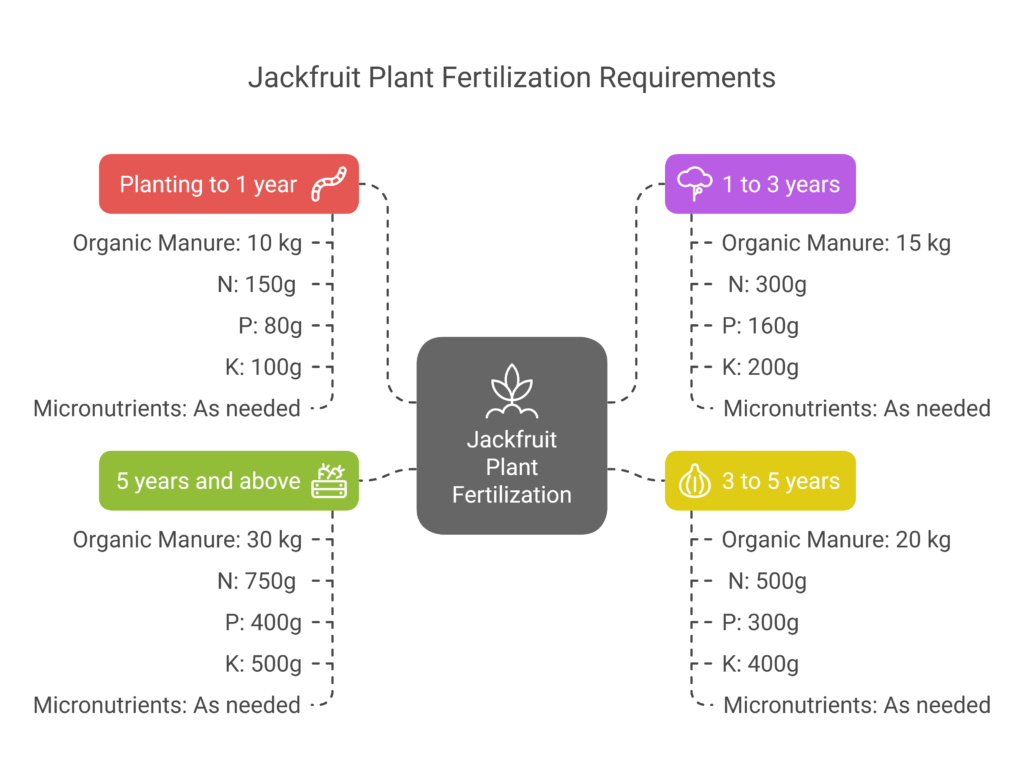
| Growth Stage | Fertilizer Requirement (per Plant per Year) | Remarks |
| Planting to 1 year | Organic Manure: 10 kg N 150g; P 80g; K 100g Micronutrients: As needed | Focus on root development and establishment. |
| 1 to 3 years | Organic Manure: 15 kg N 300g; P 160g; K 200g Micronutrients: As needed | Promote vegetative growth and canopy development. |
| 3 to 5 years | Organic Manure: 20 kg N 500g; P 300g; K 400 g Micronutrients: As needed | Support continued growth and early fruiting. |
| 5 years and above | Organic Manure: 30 kg N 750g; P 400g; K 500g Micronutrients: As needed | Focus on fruit production and quality. |
Weed Control during Jackfruit Cultivation
Weed control is crucial, especially during the early stages of growth, and can be managed through regular weeding, mulching around the base of the tree to suppress weeds and retain soil moisture, and cautious use of herbicides, though manual weeding is generally preferred; integrated weed management should be encouraged by incorporating practices such as growing cover crops, intercropping, hand weeding, and selective herbicide use wherever necessary.
Pest and Disease Management During Jackfruit Cultivation
Common pests
a). Brown weevil
Symptoms
The brown weevil damages fruits and buds by creating holes, tunnels, or feeding marks, with grubs and adults feeding and reproducing inside, leading to premature fruit drop and significant yield losses due to the destruction of fruits and buds.
Management
Destroying fallen fruits and buds, collection and destruction of grubs and adults and spraying the trees with monocrotophos (0.035 %).
b). Shoot and Fruit borer
Symptoms
The shoot and fruit borer causes damage by boring into shoots and fruits, leading to wilting, fruit rot, premature fruit drop, and visible frass.
Management
Spray monocrotophos 36 WSC 2ml/ litre or carbaryl 50 WP 0.1 %,4gms or copper oxychloride at 0.25 % to check if there is fruit rot incidence.
Common diseases
a). Fruit rot
Symptoms
Fruit rot in jackfruit is characterized by dark or brown spots that spread over the fruit, leading to softening, watery decay, and a foul odor due to microbial activity. Severely infected fruits may drop prematurely, causing yield losses, while advanced stages often show visible fungal growth or spores on the fruit surface.
Management
To control fruit rot, spray trees with young fruits using captan (0.2%), Bordeaux mixture (1.0%), or copper oxychloride (0.25%) at three-week intervals during January, February, and March. Regular application helps prevent the spread of the disease and protects fruit quality.
b). Dieback
Symptoms
Dieback in jackfruit is marked by the drying and browning of twig tips, wilting and yellowing of leaves, dark sunken cankers on branches, stunted growth, and, in severe cases, the gradual decline of the entire tree as the disease spreads to larger branches.
Management
To control dieback, prune and remove infected twigs, followed by spraying with Carbendazim (0.1%), Thiophenate methyl (0.2%), or Chlorothalonil (0.2%). Regular monitoring and timely application of these fungicides can help manage the disease effectively.
c). Phytophthora Fruit rot
Symptoms
Phytophthora fruit rot causes water-soaked, dark, and soft spots on infected fruits, which rapidly decay into mushy, discolored areas, often accompanied by white cottony fungal growth in humid conditions; severely affected fruits drop prematurely, emitting a foul smell due to microbial activity, leading to significant yield losses.
Management
Spraying with Benomyl 1g/lit. completely controls the disease.
d). Leaf spot
Symptoms
Leaf spot disease causes small, circular, or irregular dark brown or black spots on leaves, often surrounded by yellow halos, leading to leaf yellowing, premature leaf drop, and reduced photosynthesis, which weakens the tree and impacts fruit production.
Management
To control leaf spot, spray the affected trees with Carbendazim (0.1%), Thiophanate methyl (0.2%), or Difolatan (0.2%). Regular application of these fungicides helps manage the disease and prevents further spread. Maintaining proper orchard hygiene and removing infected leaves can also reduce the risk of recurrence.
Harvesting
After planting, jackfruit usually takes three to four years to mature and start yielding edible fruits. To guarantee the best possible fruit quality, it is essential to know when to harvest. Two telltale signs of a ripe jackfruit are a deep, sweet scent and a hollow sound made when the fruit is tapped. The fruit is ready to be picked based on these indicators.
When harvesting, carefully cut the fruit from the tree with a sharp knife, leaving a little piece of the stem still attached. By doing this, the fruit’s shelf life is increased, and tree damage is avoided. Fruit should be handled carefully after harvesting to prevent bruising, which can cause spoiling and lower the fruit’s market value. The jackfruit will stay fresh and preserve its quality for sale or eating if it is harvested and handled properly.

